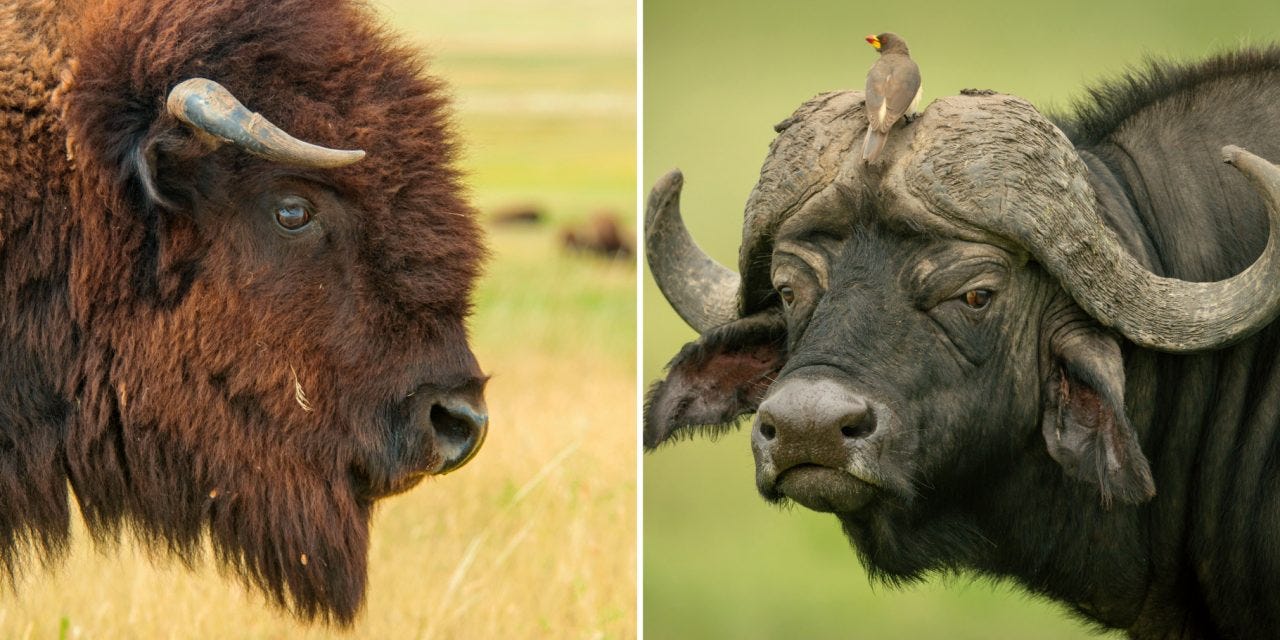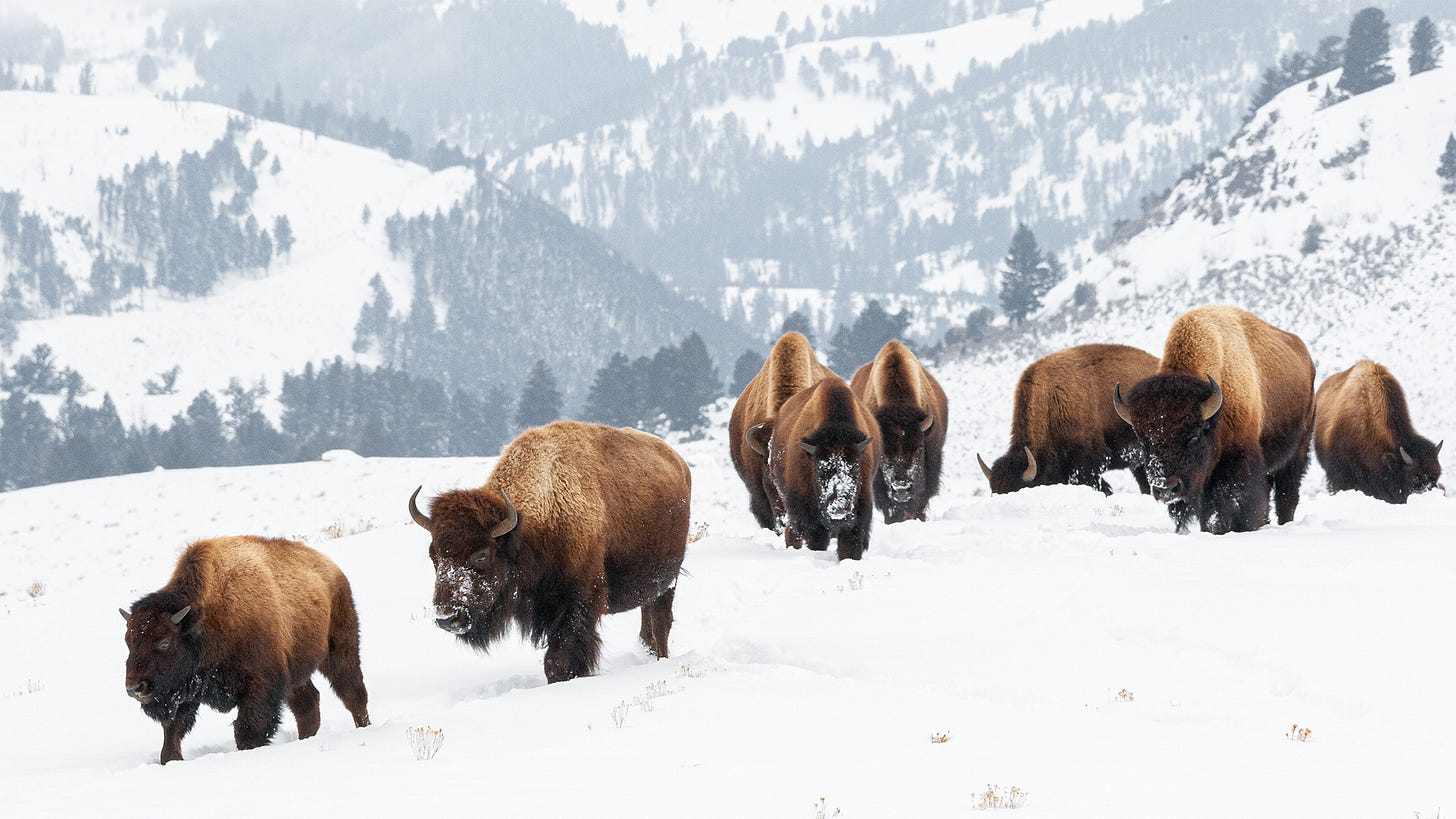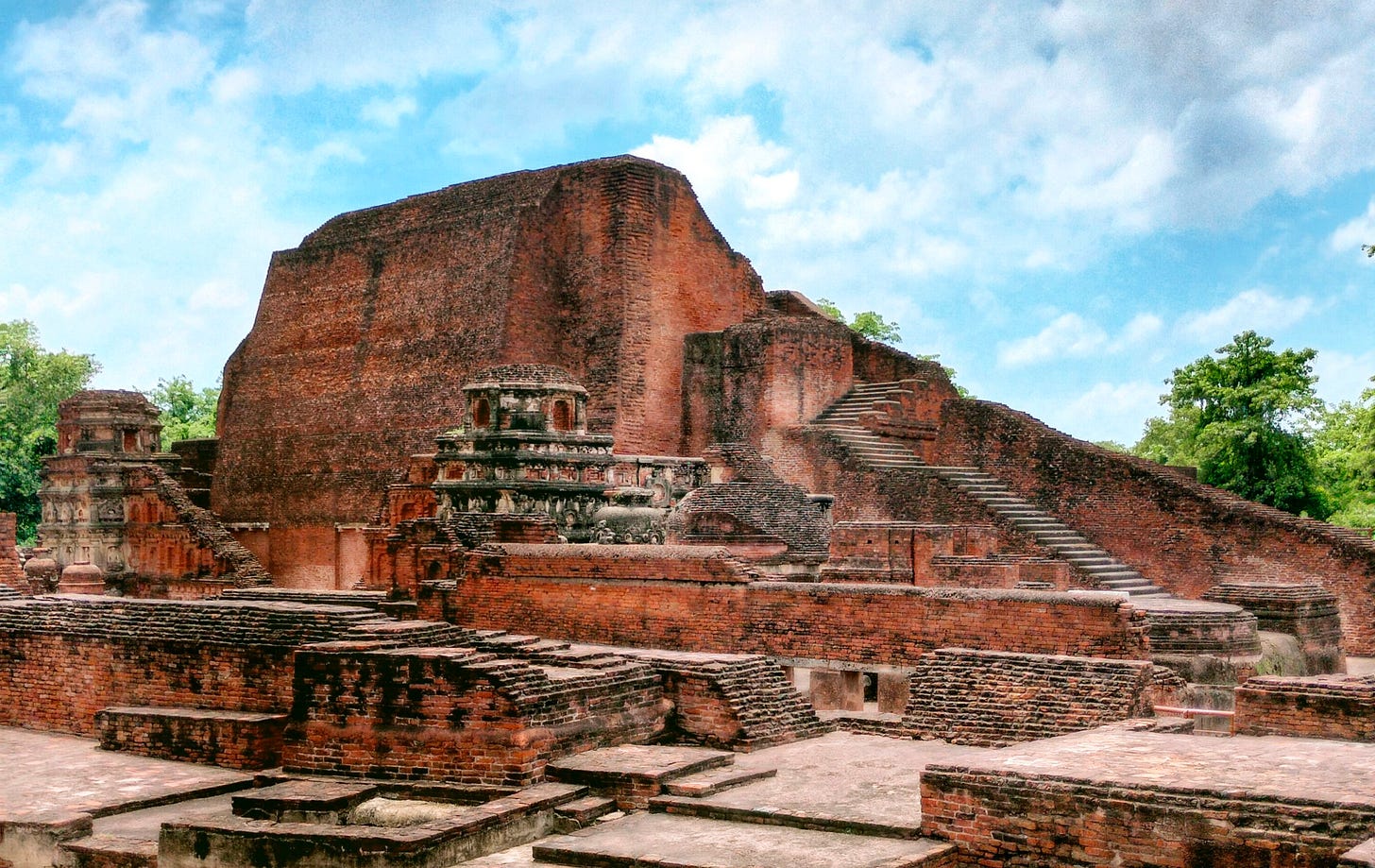
Today I learned that… we have no buffalo in North America. I’ve heard the words used interchangeably my entire life, but that’s the fault of early European colonists in North America, who mistook the bison (Bison bison) for an Eastern Hemisphere buffalo species. While the two animals are distantly related, they’re certainly distinct when placed side-by-side. Bison tend to have larger heads and wooly humps on their shoulders, while buffalo species have longer horns (some species’ horns can span 6 feet).

How are asteroids formed?
Recently, Kaito and I bought a lovely book called Phenomena: An Infographic Guide to Almost Everything. Imagine a book full of cool conference posters where each page addresses a different topic that ranges from the uncanny valley to the history of aqueducts. One of the first pages in the book talks about asteroids and how’re they’re made, which I’d completely forgotten!
When the Sun formed, its gravity gathered an enormous rotating cloud of dust and dense gas, also known as a protoplanetary disk (proplyd for short). From this cloud, tiny grains of metal and rock developed, which scientists creatively called chondrules (from the Ancient Greek χόνδρος, chondros, which means “grain”). These joined together over time to create over 80% of the asteroids in our solar system today.

A majority of our solar system’s asteroids lie in the asteroid belt, a torus-shaped region between Mars and Jupiter. The size of the asteroids varies from specks to dwarf planets. (Think of that scene from Star Wars: The Empire Strikes Back where Han Solo hides the Millennium Falcon in the digestive tract of an… asteroid worm? We’re talking that size.) I always wondered why our asteroid belt formed as a somewhat disk-like shape and, well, it turns out the reason relates to the aforementioned protoplanetary disk. Objects tend to orbit in the same plane as the disk, and while over time some have scattered from the main plain due to collision events, the majority remain relatively close.
Before I move on, I’m curious: do you know/remember the difference between an asteroid and a meteoroid? I mistakenly use these terms interchangeably (a theme in this week’s newsletter), but they technically describe different things. We’ve already defined an asteroid—a rocky object orbiting a star—but a meteoroid is made when asteroids or comet fragments collide with another body in space, shooting fragments out on their own journey around the Sun. If a meteoroid’s journey take it too close to the Earth’s atmosphere, then it becomes a meteor. Most meteors burn away before they strike the Earth, but those that strike the surface are called meteorites.
A lot of terms to describe some space rocks!
A Medical Explanation for “Possessions?”

Have you ever wondered why so many humans believed in possession? Personally, I’ve never seen any evidence for such a thing, but historical records from around the globe are rife with tales of spiritual possessions—particularly throughout Eurasia.
In societies influenced by the Abrahamic religions, these stories tend to follow a similar pattern: 1) a person or people start to suffer disturbing dreams and/or exhibit violent convulsions and abnormal behavior; 2) this malady is blamed on a practitioner of magic, and; 3) the practitioner is punished by the community or the state. In Western Europe, women were usually the victims of the vigilante justice as belief in witchcraft causing possessions was widespread; however, I’ve read that this wasn’t always the case. For instance, in the medieval Roman Empire (my perennial favorite topic), female magic practitioners (lol) were more often associated with “hypersexual desires” or causing birth defects, among other perceived transgressions.1 But, more often than not, women bore the brunt of these accusations of possession.
Let’s go back to talking about actual “possessions,” though. What did these events look like? Well, I found an example in the historical record that cites an instance in 994 AD.2 A widespread outbreak in France occurred that year—symptoms included hysterics, hallucinations, and wild dancing. Some victims danced themselves to death, but I’ll spare you a detailed account of that. According to the source that I read, approximately 44,000 people were affected by this seemingly supernatural event, dubbed an episode of “holy fire” or “Saint Anthony’s Fire” by contemporary Europeans.
Modern humans have a different name and explanation for this: ergotism.
Ergotism is a type of poisoning produced by consuming grain-based foods contaminated with the ergot fungus. The poisoning can take two routes in the human body: convulsive or gangrenous ergotism. We’re going to focus on the convulsive ergotism for reasons that will become clear soon. Convulsive ergotism occurs when large quantities of ergotamine and dihydroergotamine bind to receptors in the brain, which cause the narrowing of blood vessels and hormonal imbalances. Beyond more “ordinary” upper-respiratory symptoms, victims will experience convulsions, violent muscle spasms, paranoid delusions, and vivid hallucinations. The latter symptom is triggered by lysergic acid present in ergot fungus, which is also the chemical compound found in L.S.D.
Well, doesn’t that sound familiar?
It’s pretty difficult to conclusively determine illnesses that plagued humans of the distant past, but modern academics seem to think all the signs of “possessed people” point to ergotism. Luckily, with the advent of modern medicines and microbiology, ergotism has ceased to be a problem for a vast majority of humans. Maybe that’s why I’ve not seen any demonic possessions of late!
Ancient Chinese Oral Care (this one is for you, Mom)

On Wednesday, I went down a very weird line of inquiry involving ancient teeth cleaning methods (it was for book worldbuilding—don’t ask). That led me to a Chinese-language video on YouTube that opened a whole new can of worms (bottle of mouthwash?) to explore: ways that premodern Chinese people cleaned their mouths.
Contrary to earlier preconceptions that I had based on English history—y’know, people living with constant tooth aches and loosing all their teeth by age 25—the premodern Chinese had many popular methods for keeping their mouths clean. For one, they had toothbrushes! The device was invented in China as early as the Tang Dynasty (pronounced “Tahng,” like the American pronunciation of the word “song”), but was likely only available to wealthier households as it was made of animal bones and coarse hair (e.g., horse hair). The ordinary person would have instead soaked a willow twig or other fibrous wood overnight before chewing on it in the morning. The softened fibers would scrub the person’s teeth and gums clean without hurting them.
Premodern Chinese people also had toothpaste to accompany their toothbrushing! The recipes passed down to us vary over the centuries, but common ingredients include wild ginger paste, Chinese angelica, cohosh, boiled locust branches, boiled mulberry branches, and hibiscus powder. Some of the more expensive concoctions used agarwood. Invariably, these would be ground down to a paste to use on the teeth, whether dabbed, rubbed, or brushed onto the surface. The Chinese also used rinses after meals, such as gargling salt water, alcohol, or tea, depending on what was available.
Don’t get me wrong: even with all of these hygienic practices, my findings seem to indicate that partial tooth loss was fairly common in premodern China, albeit less so than in contemporary European societies, where it wasn’t uncommon to lose all of your teeth before death. Interestingly, tooth cavities were less frequent in European populations than in China, although this could largely be attributed to differences in diet rather than oral care.
Upcoming…
Now that I’m back home and finished with writing a book, you can expect regular programming for this newsletter. I feel like I have the capacity to begin work on the Deep Dive series I’d started a while back (this is paid subscriber content) and also have an interesting Cities episode coming next week. This time, we’re heading to India.
Until then, I hope you have a great weekend,
Blake

Alicia Walker. “Magic in Medieval Byzantium.” The Cambridge History of Magic and Witchcraft in the West: From Antiquity to the Present, (Cambridge University Press, 2015): 221. https://archive.org/details/magic_in_medieval_byzantium/page/n11/mode/2up
Bennett, J. W., and Ronald Bentley. “Pride and Prejudice: The Story of Ergot.” Perspectives in Biology and Medicine 42, no. 3 (1999): 333-355. https://dx.doi.org/10.1353/pbm.1999.0026.



